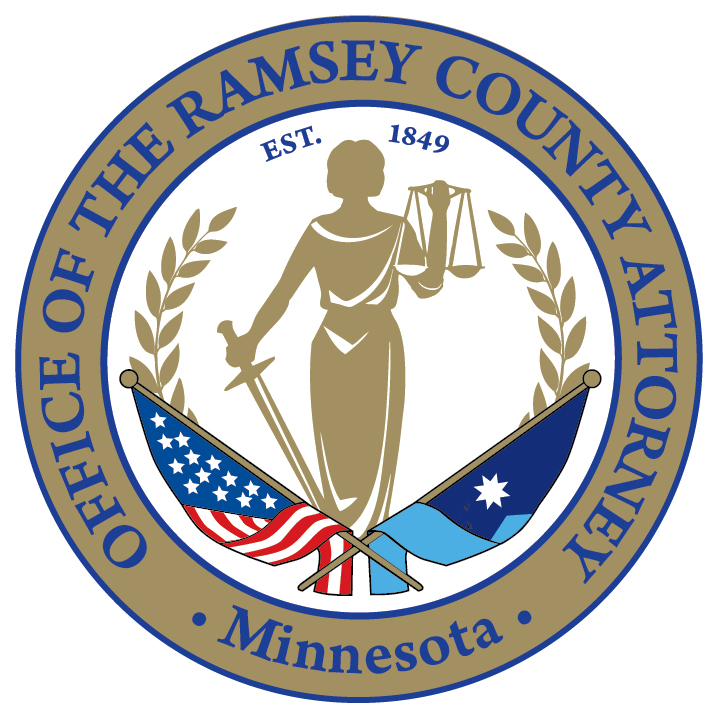Court Proceedings
Our office is responsible for prosecuting all felonies and some gross misdemeanors, misdemeanors and petty misdemeanors occurring in Ramsey County. Understanding what happens in court is vital to understanding how the criminal justice system works.
Overview
When a complaint is issued by the County Attorney's Office and signed by a judge:
- The defendant is scheduled for a first appearance in court, at which the judge:
- ensures an attorney represents the defendant, and
- decides whether the defendant should be held in jail or required to post bail until trial.
- Two weeks later, an omnibus hearing is held, at which the judge:
- determines if there is sufficient evidence to take the case to trial,
- gives the defendant the opportunity to plead guilty or not guilty, and
- sets a trial date, usually within 60 days unless the defendant asks for or agrees to a trial at a later date.
Conditions of jail or release
Under the laws of the United States and State of Minnesota, a defendant is innocent until proven guilty.
- A defendant's release based on his/her promise to appear at future court appearances is common.
- If the court determines the defendant is unlikely to appear at future court dates or is a threat to public safety, bail or special conditions of release, such as no contact with victims or witnesses, may be imposed.
- Bail is a deposit of money held by the court that can be forfeited if the defendant fails to appear in court, breaks the law or violates the conditions of release.
- You should notify the prosecutor of any concerns you have regarding a defendant's release or known violations of a defendant's release conditions.
Trial process
In most cases, the defendant pleads guilty and a trial is not needed. A plea negotiation is an agreement to settle a criminal case by a plea of guilty, or other appropriate disposition, without a trial, when it appears to be in the interest of the public, the victim and the effective administration of justice.
Pending trial
- Cooperate with the prosecutor and law enforcement. You may be contacted for further information.
- Our office will tell you of any special things you should do pending trial.
- If you change your address or phone number, contact us as soon as possible.
- Immediately report to police and our office if the defendant or others attempt to influence you through threats or coercion. Tampering with a witness is a punishable crime.
Testifying
- Testimony of victims is usually not required until the trial.
- Whether you will have to testify will be determined at the time of trial.
- If your testimony is needed, you will receive a subpoena telling you where and when to appear.
- Additional information will be sent to help you prepare for your court appearance.
Trial proceedings
- The trial may be before a jury of 12 people, or only a judge, depending on what the defendant requests.
- The trial begins with both sides having the opportunity to make an opening statement on the facts they expect to prove.
- The prosecutor then presents the state's case by using witnesses and exhibits.
- When the prosecutor is finished, the defense attorney may give an opening statement if it has not already been given.
- The defense attorney then may present a case using witnesses and exhibits. The defendant is not required to prove anything. The defendant can decide not to testify.
- When the defense has completed its case, both sides are allowed to make closing arguments, with the prosecutor going first.
- The judge or jury will make a decision of guilty or not guilty.
- The prosecutor must prove the defendant guilty beyond a reasonable doubt.
Sentencing
Before sentencing, a pre-sentence investigation is prepared which includes both a social and criminal history of the defendant, victim impact information, restitution information and any recommendations to the court by the pre-sentence investigator regarding sentencing. The prosecutor and defense attorney may also make recommendations to the judge regarding sentencing.
The sentencing judge must apply the Minnesota Sentencing Guidelines, which give a presumptive sentence that a defendant should receive based upon the seriousness of the crime and the defendant's criminal record. When a probationary sentence is called for by the Guidelines, a judge may impose county jail time, fines, treatment, restitution, community service or other requirements as conditions of probation.
